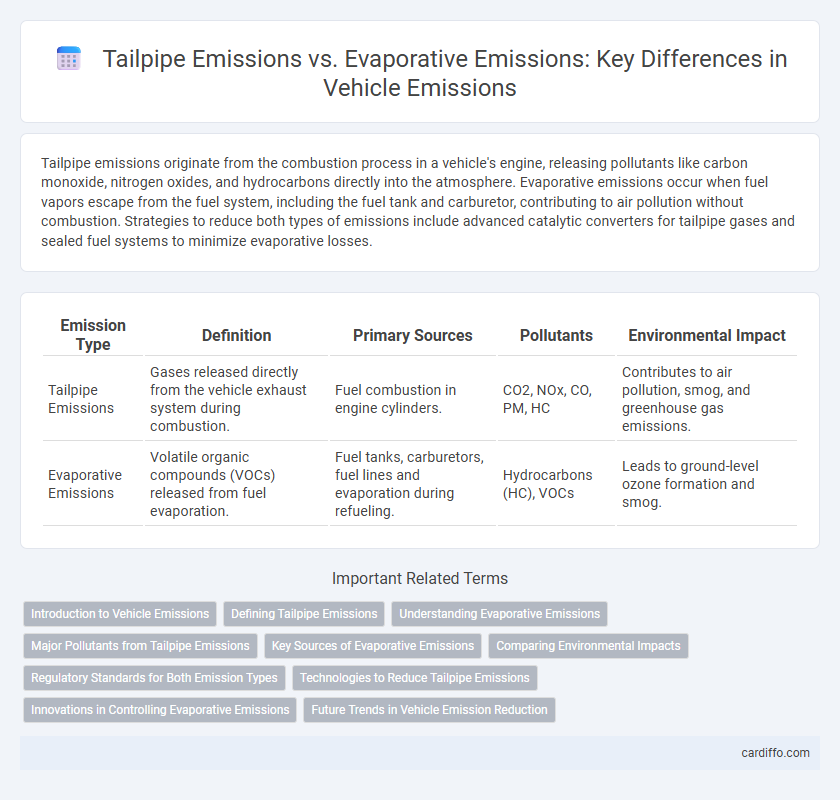Tailpipe emissions originate from the combustion process in a vehicle's engine, releasing pollutants like carbon monoxide, nitrogen oxides, and hydrocarbons directly into the atmosphere. Evaporative emissions occur when fuel vapors escape from the fuel system, including the fuel tank and carburetor, contributing to air pollution without combustion. Strategies to reduce both types of emissions include advanced catalytic converters for tailpipe gases and sealed fuel systems to minimize evaporative losses.
Table of Comparison
| Emission Type | Definition | Primary Sources | Pollutants | Environmental Impact |
|---|---|---|---|---|
| Tailpipe Emissions | Gases released directly from the vehicle exhaust system during combustion. | Fuel combustion in engine cylinders. | CO2, NOx, CO, PM, HC | Contributes to air pollution, smog, and greenhouse gas emissions. |
| Evaporative Emissions | Volatile organic compounds (VOCs) released from fuel evaporation. | Fuel tanks, carburetors, fuel lines and evaporation during refueling. | Hydrocarbons (HC), VOCs | Leads to ground-level ozone formation and smog. |
Introduction to Vehicle Emissions
Tailpipe emissions consist of pollutants released directly from a vehicle's exhaust system during combustion, including carbon monoxide, nitrogen oxides, and particulate matter. Evaporative emissions originate from the release of fuel vapors into the atmosphere, occurring through fuel system components such as the fuel tank, carburetor, and fuel lines. Understanding these distinct sources is essential for comprehensive vehicle emissions control and pollution reduction strategies.
Defining Tailpipe Emissions
Tailpipe emissions refer to the pollutants released directly from a vehicle's exhaust system during combustion, primarily including carbon monoxide (CO), nitrogen oxides (NOx), hydrocarbons (HC), and particulate matter (PM). These emissions result from burning fuel in the engine and contribute significantly to urban air pollution and smog formation. Tailpipe emissions are regulated under stringent environmental standards such as the EPA's Tier 3 and the European Euro 6 to reduce harmful impacts on human health and the environment.
Understanding Evaporative Emissions
Evaporative emissions occur when fuel vapors escape from a vehicle's fuel system, including the fuel tank, fuel lines, and carburetor, without combustion. These emissions consist primarily of volatile organic compounds (VOCs) that contribute to ground-level ozone formation and smog. Understanding evaporative emissions is crucial for improving emission control technologies such as onboard refueling vapor recovery (ORVR) and charcoal canisters, which help capture and reduce these harmful vapors.
Major Pollutants from Tailpipe Emissions
Tailpipe emissions primarily release major pollutants such as nitrogen oxides (NOx), carbon monoxide (CO), particulate matter (PM), and volatile organic compounds (VOCs), which contribute significantly to urban air pollution and respiratory health issues. These emissions result from the incomplete combustion of fuel in internal combustion engines, leading to the formation of smog and ozone. Understanding the chemical composition and volume of these pollutants is essential for regulatory policies and the development of cleaner vehicle technologies.
Key Sources of Evaporative Emissions
Key sources of evaporative emissions include fuel tank vapor displacement, carburetor fuel evaporation, and permeation through fuel system components such as hoses and seals. These emissions release volatile organic compounds (VOCs) into the atmosphere without combustion, contributing significantly to air pollution and smog formation. Controlling evaporative emissions involves technologies like onboard refueling vapor recovery (ORVR), carbon canisters, and improved fuel system designs.
Comparing Environmental Impacts
Tailpipe emissions release pollutants such as nitrogen oxides, carbon monoxide, and particulate matter directly into the atmosphere, contributing significantly to air quality deterioration and respiratory issues. Evaporative emissions, primarily volatile organic compounds (VOCs) from fuel evaporation, contribute to ground-level ozone formation and smog, posing long-term environmental and health risks. Comparing their impacts, tailpipe emissions tend to have more immediate and localized effects, while evaporative emissions contribute substantially to cumulative atmospheric pollution and urban smog.
Regulatory Standards for Both Emission Types
Tailpipe emissions are regulated under standards such as the U.S. Environmental Protection Agency's Tier 3 and California Air Resources Board's LEV III programs, targeting pollutants like nitrogen oxides, carbon monoxide, and particulate matter. Evaporative emissions are controlled through regulations including the EPA's Evaporative Emission Standards and California's Enhanced Evaporative Emission Standards, which limit volatile organic compound (VOC) releases from fuel systems and storage. Both types of emissions require compliance with stringent testing procedures to meet federal and state mandates aimed at reducing air pollution and protecting public health.
Technologies to Reduce Tailpipe Emissions
Advanced catalytic converters and selective catalytic reduction (SCR) systems significantly reduce tailpipe emissions by converting harmful gases such as nitrogen oxides (NOx), carbon monoxide (CO), and hydrocarbons (HC) into less toxic substances like nitrogen, carbon dioxide, and water vapor. Exhaust gas recirculation (EGR) technology lowers NOx emissions by recirculating a portion of exhaust gas back into the engine cylinder, reducing combustion temperature. Additionally, particulate filters trap and remove fine particulate matter (PM) from diesel and gasoline engines, further minimizing harmful exhaust pollutants.
Innovations in Controlling Evaporative Emissions
Innovations in controlling evaporative emissions have focused on advanced carbon canister technologies and improved sealing materials that prevent fuel vapor leaks. Modern vehicles employ sophisticated onboard diagnostics (OBD) systems to detect and reduce evaporative emissions effectively. These advancements significantly minimize hydrocarbon release, complementing efforts to reduce tailpipe emissions and improve overall air quality.
Future Trends in Vehicle Emission Reduction
Future trends in vehicle emission reduction emphasize advanced technologies targeting both tailpipe and evaporative emissions to meet stringent environmental regulations. Innovations in electric and hydrogen fuel cell vehicles significantly reduce tailpipe emissions, while improved sealing materials and onboard diagnostics minimize evaporative losses from fuel systems. Regulatory frameworks like Euro 7 and LEV III drive continuous improvements in emission control systems, promoting widespread adoption of zero-emission and low-emission vehicles globally.
Tailpipe Emissions vs Evaporative Emissions Infographic

 cardiffo.com
cardiffo.com